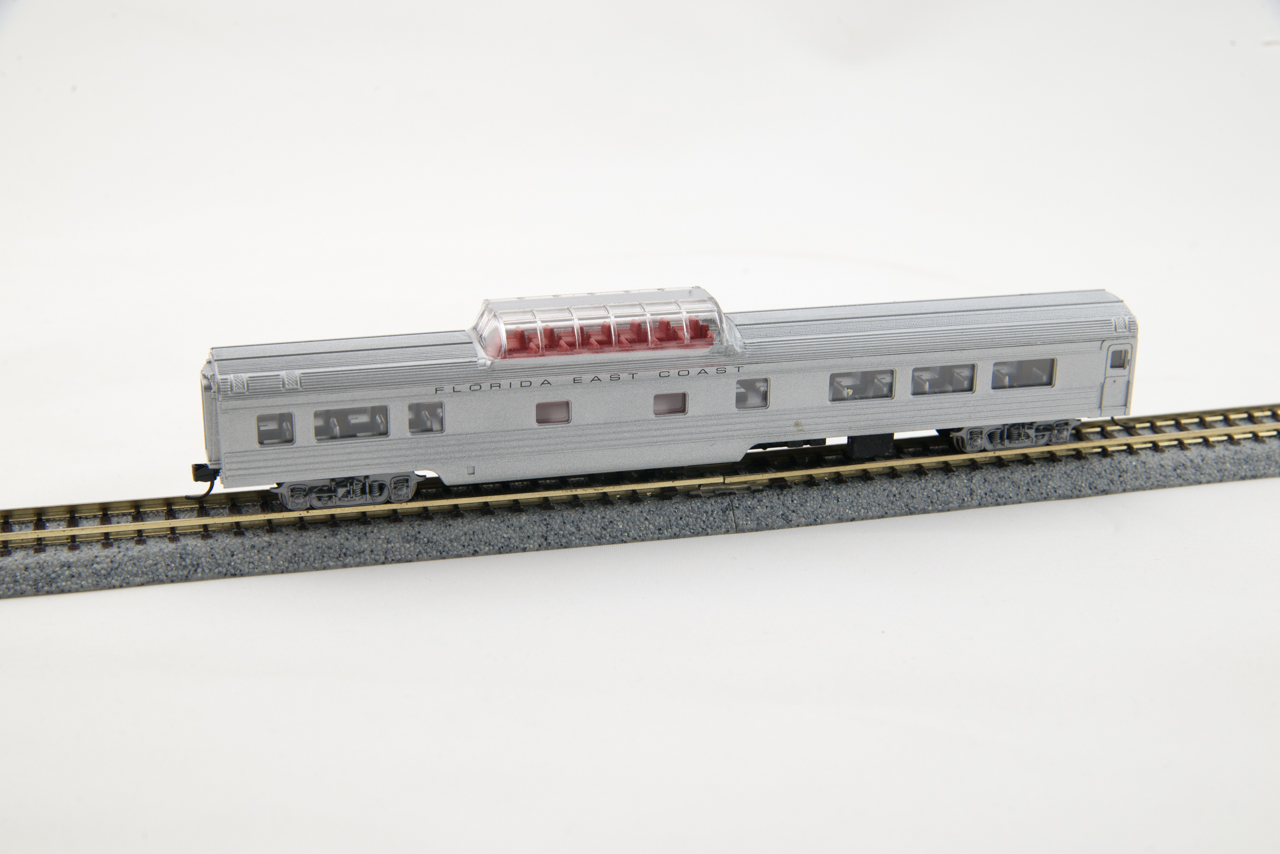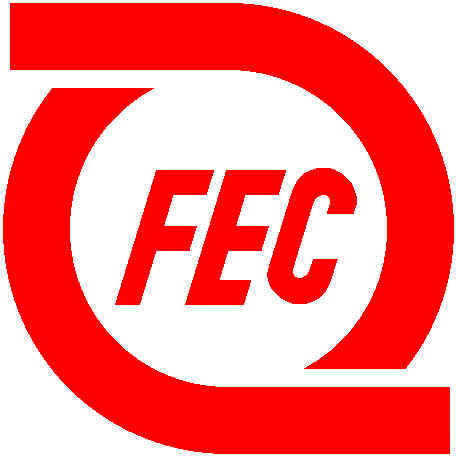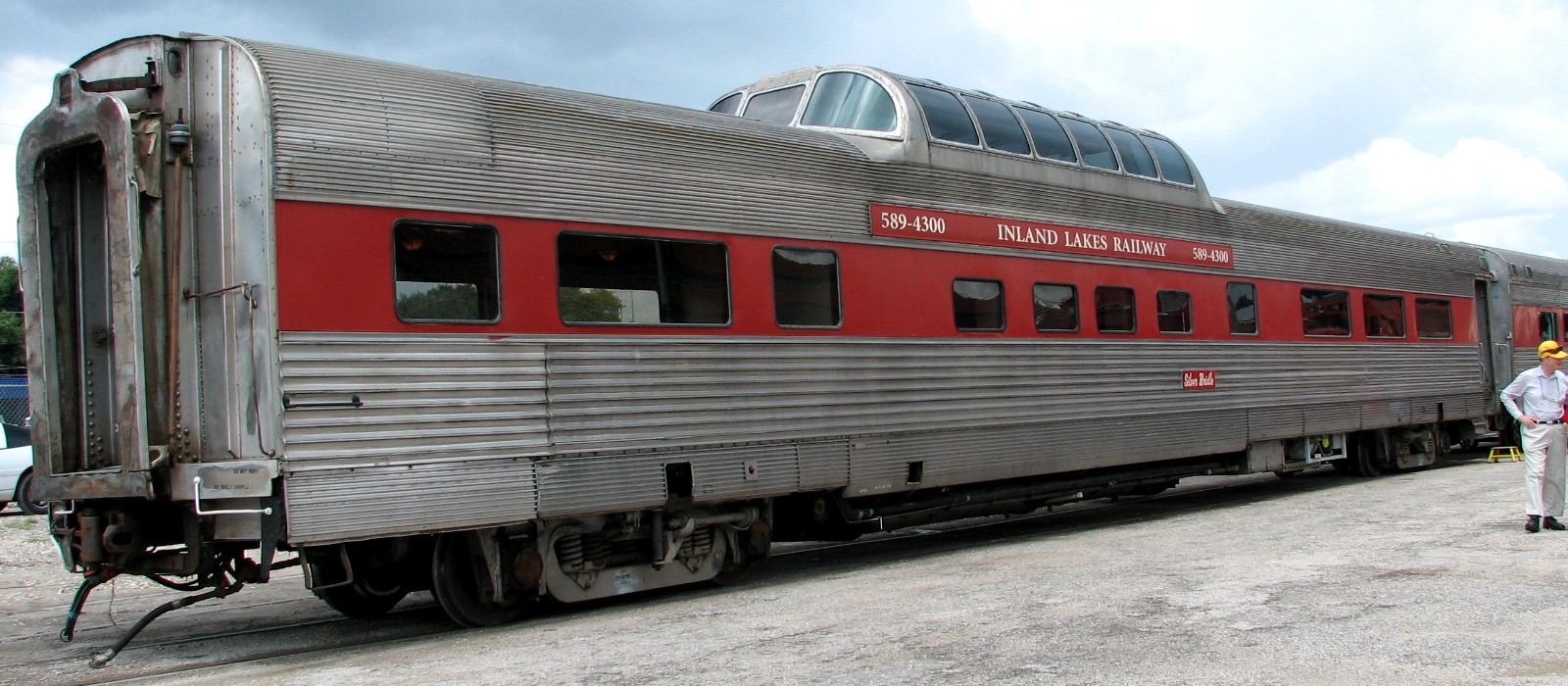Model Information: This car is a bit of an odd-ball. It was apparently originally made in the 1970s by Kato for Con-Cor. Early examples are labeled Sekisui/Con-Cor Japan. Later examples have the label milled out and replaced with 'Con-Cor'. This would presume that the tooling was moved from Japan to the United states at some point.
Early versions came in kit form with Rapido couplers. Later versions are Ready-to-Run (RTR) and come with either dummy knuckle "Rigid Face" couplers or Micro-Trains couplers.
It is modeled after the 46-seat dome-coach built by Budd for the CB&Q (Burlington Route) in 1956 to run on the Denver Zephyr (DZ). It is very similar to the 46-seat dome-coach built by Budd for Great Northern’s 1955 Empire Builder, the latter having “slab panel” sides instead of corrugated sides.
Despite the model having corrugated sides, Con-Cor marketed and packaged it either as a 'Corrugated Dome' (stainless steel finish) or a 'Smoothside Dome' (painted finish). The Con-Cor literature refers to it as a 'mid-train dome', which means it is not a dedicated tail car and can be used between other passenger cars.
Yet, in spite of the Con-Cor labeling and manufacturing , the Con-Cor website sometimes refers to this model as a 'Rivarossi Corrugated Dome', with a stock number starting with 0003- or 003- that is the company prefix used by Con-Cor for Rivarossi products. This is actually to complement the Rivarossi lightweight corrugated range that is missing a dome car, in particular in the Con-Cor/Rivarossi 5-car corrugated passenger sets.
So, though the 'corrugated' and 'smoothside' versions are marketed with different denominations by Con-Cor, they are technically of the same model type, hence are all regrouped in this single body style.
Warning: Con-cor designed subsequently another mid-train corrugated dome, inspired by another Budd dome built for the California Zephyr, that is not to be confused with this one.
Early versions came in kit form with Rapido couplers. Later versions are Ready-to-Run (RTR) and come with either dummy knuckle "Rigid Face" couplers or Micro-Trains couplers.
It is modeled after the 46-seat dome-coach built by Budd for the CB&Q (Burlington Route) in 1956 to run on the Denver Zephyr (DZ). It is very similar to the 46-seat dome-coach built by Budd for Great Northern’s 1955 Empire Builder, the latter having “slab panel” sides instead of corrugated sides.
Despite the model having corrugated sides, Con-Cor marketed and packaged it either as a 'Corrugated Dome' (stainless steel finish) or a 'Smoothside Dome' (painted finish). The Con-Cor literature refers to it as a 'mid-train dome', which means it is not a dedicated tail car and can be used between other passenger cars.
Yet, in spite of the Con-Cor labeling and manufacturing , the Con-Cor website sometimes refers to this model as a 'Rivarossi Corrugated Dome', with a stock number starting with 0003- or 003- that is the company prefix used by Con-Cor for Rivarossi products. This is actually to complement the Rivarossi lightweight corrugated range that is missing a dome car, in particular in the Con-Cor/Rivarossi 5-car corrugated passenger sets.
So, though the 'corrugated' and 'smoothside' versions are marketed with different denominations by Con-Cor, they are technically of the same model type, hence are all regrouped in this single body style.
Warning: Con-cor designed subsequently another mid-train corrugated dome, inspired by another Budd dome built for the California Zephyr, that is not to be confused with this one.
Prototype History: A dome car is a type of railway passenger car that has a glass dome on the top of the car where passengers can ride and see in all directions around the train. It also can include features of a coach, lounge car, dining car, sleeping car or observation. Beginning in 1945, dome cars were primarily used in the United States and Canada, though a small number were constructed in Europe for Trans Europ Express service, and similar panorama cars are in service on Alpine tourist railways like the Bernina Express.
In North America, dome cars were manufactured by the Budd Company, Pullman Standard and American Car & Foundry. Southern Pacific Railroad built its own dome cars in its Sacramento, California, shops. In the 1990s Colorado Railcar began producing dome cars. Generally, seats in the dome were considered "non-revenue" like lounge car seats. When dome cars operate today in excursion trains, the dome seats often command a premium fare.
In North America, dome cars were manufactured by the Budd Company, Pullman Standard and American Car & Foundry. Southern Pacific Railroad built its own dome cars in its Sacramento, California, shops. In the 1990s Colorado Railcar began producing dome cars. Generally, seats in the dome were considered "non-revenue" like lounge car seats. When dome cars operate today in excursion trains, the dome seats often command a premium fare.
Road Name History: The Florida East Coast Railway (reporting mark FEC) is a Class II railroad operating in the U.S. state of Florida and since 2007 has been a subsidiary of Railroad Acquisition Holdings, LLC, itself a subsidiary of Fortress Investment Group, LLC.
The FEC was historically a Class I railroad owned by Florida East Coast Industries (FECI) from 2000-2006, FOXX Holdings from 1983-2000, and the St. Joseph Paper Company prior to 1983.
Built primarily in the last quarter of the 19th century and the first decade of the 20th century, the FEC was a project of Standard Oil principal Henry Morrison Flagler. Flagler originally visited Florida to aid with the health issues faced by his first wife, Mary. A key strategist who worked closely with John D. Rockefeller building the Standard Oil Trust, Henry Flagler noted both a lack of services and great potential during his stay at St. Augustine. He subsequently began what amounted to his second career developing resorts, industries, and communities all along Florida's shores abutting the Atlantic Ocean.
The FEC is possibly best known for building the railroad to Key West, completed in 1912. When the FEC's line from the mainland to Key West was heavily damaged by the Labor Day Hurricane of 1935, the State of Florida purchased the remaining right-of-way and bridges south of Dade County, and they were rebuilt into road bridges for vehicle traffic and became known as the Overseas Highway. However, a greater and lasting Flagler legacy was the developments along Florida's eastern coast.
During the Great Depression, control was purchased by heirs of the du Pont family. After 30 years of fragile financial condition, the FEC, under leadership of a new president, Ed Ball, took on the labor unions. Ball claimed the company could not afford the same costs as larger Class 1 railroads and needed to invest saved funds in its infrastructure, fast becoming a safety issue. Using replacement workers, the company and some of its employees engaged in one of the longest and more violent labor conflicts of the 20th century from 1963 until 1977. Ultimately, federal authorities had to intervene to stop the violence, which included bombings, shootings and vandalism. However, the courts ruled in the FEC's favor with regard to the right to employ strikebreakers. During this time, Ball invested heavily in numerous steps to improve its physical plant, installed various forms of automation,was the first US Railroad to operate two man train crews, eliminate cabooses and end all of its passenger services (which were unprofitable) by 1968.
In modern times, the company's primary rail revenues come from its intermodal and rock trains. Since 2007, it has been owned by Fortress Investment Group,[citation needed] which acquired it for over US$3 billion (including non-rail assets). Fortress previously owned conglomerate short line railroad operator RailAmerica, which for a time operated FEC but the two companies never merged; Fortress no longer owns RailAmerica and RailAmerica no longer operates FEC. A former CSX official, James Hertwig, was named as President and Chief Executive Officer of the company effective July 1, 2010.
From Wikipedia
The FEC was historically a Class I railroad owned by Florida East Coast Industries (FECI) from 2000-2006, FOXX Holdings from 1983-2000, and the St. Joseph Paper Company prior to 1983.
Built primarily in the last quarter of the 19th century and the first decade of the 20th century, the FEC was a project of Standard Oil principal Henry Morrison Flagler. Flagler originally visited Florida to aid with the health issues faced by his first wife, Mary. A key strategist who worked closely with John D. Rockefeller building the Standard Oil Trust, Henry Flagler noted both a lack of services and great potential during his stay at St. Augustine. He subsequently began what amounted to his second career developing resorts, industries, and communities all along Florida's shores abutting the Atlantic Ocean.
The FEC is possibly best known for building the railroad to Key West, completed in 1912. When the FEC's line from the mainland to Key West was heavily damaged by the Labor Day Hurricane of 1935, the State of Florida purchased the remaining right-of-way and bridges south of Dade County, and they were rebuilt into road bridges for vehicle traffic and became known as the Overseas Highway. However, a greater and lasting Flagler legacy was the developments along Florida's eastern coast.
During the Great Depression, control was purchased by heirs of the du Pont family. After 30 years of fragile financial condition, the FEC, under leadership of a new president, Ed Ball, took on the labor unions. Ball claimed the company could not afford the same costs as larger Class 1 railroads and needed to invest saved funds in its infrastructure, fast becoming a safety issue. Using replacement workers, the company and some of its employees engaged in one of the longest and more violent labor conflicts of the 20th century from 1963 until 1977. Ultimately, federal authorities had to intervene to stop the violence, which included bombings, shootings and vandalism. However, the courts ruled in the FEC's favor with regard to the right to employ strikebreakers. During this time, Ball invested heavily in numerous steps to improve its physical plant, installed various forms of automation,was the first US Railroad to operate two man train crews, eliminate cabooses and end all of its passenger services (which were unprofitable) by 1968.
In modern times, the company's primary rail revenues come from its intermodal and rock trains. Since 2007, it has been owned by Fortress Investment Group,[citation needed] which acquired it for over US$3 billion (including non-rail assets). Fortress previously owned conglomerate short line railroad operator RailAmerica, which for a time operated FEC but the two companies never merged; Fortress no longer owns RailAmerica and RailAmerica no longer operates FEC. A former CSX official, James Hertwig, was named as President and Chief Executive Officer of the company effective July 1, 2010.
From Wikipedia
Brand/Importer Information: Con-Cor has been in business since 1962. Many things have changed over time as originally they were a complete manufacturing operation in the USA and at one time had upwards of 45 employees. They not only designed the models,but they also built their own molds, did injection molding, painting, printing and packaging on their models.
Currently, most of their manufacturing has been moved overseas and now they import 90% of their products as totally finished goods, or in finished components. They only do some incidental manufacturing today within the USA.
Important Note: The Con-Cor product numbering can be very confusing. Please see here in the article how to properly enter Con-Cor stock numbers in the TroveStar database.
Currently, most of their manufacturing has been moved overseas and now they import 90% of their products as totally finished goods, or in finished components. They only do some incidental manufacturing today within the USA.
Important Note: The Con-Cor product numbering can be very confusing. Please see here in the article how to properly enter Con-Cor stock numbers in the TroveStar database.
Item created by: CNW400 on 2020-06-15 11:19:53
Last edited by: Powderman on 2021-03-19 14:48:14
If you see errors or missing data in this entry, please feel free to log in and edit it. Anyone with a Gmail account can log in instantly.
Last edited by: Powderman on 2021-03-19 14:48:14
If you see errors or missing data in this entry, please feel free to log in and edit it. Anyone with a Gmail account can log in instantly.











